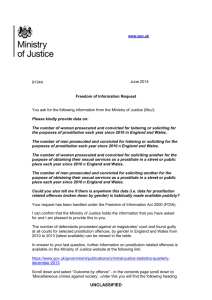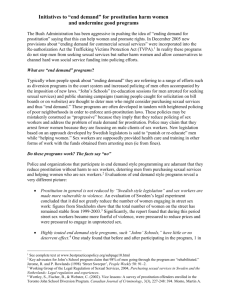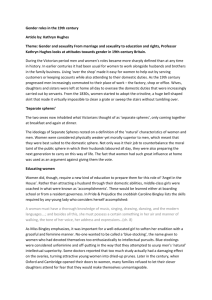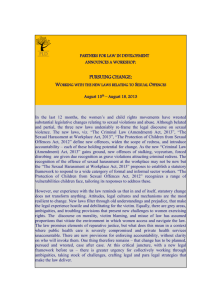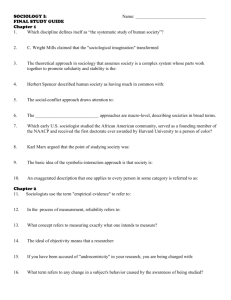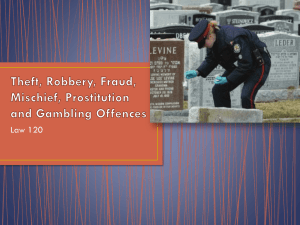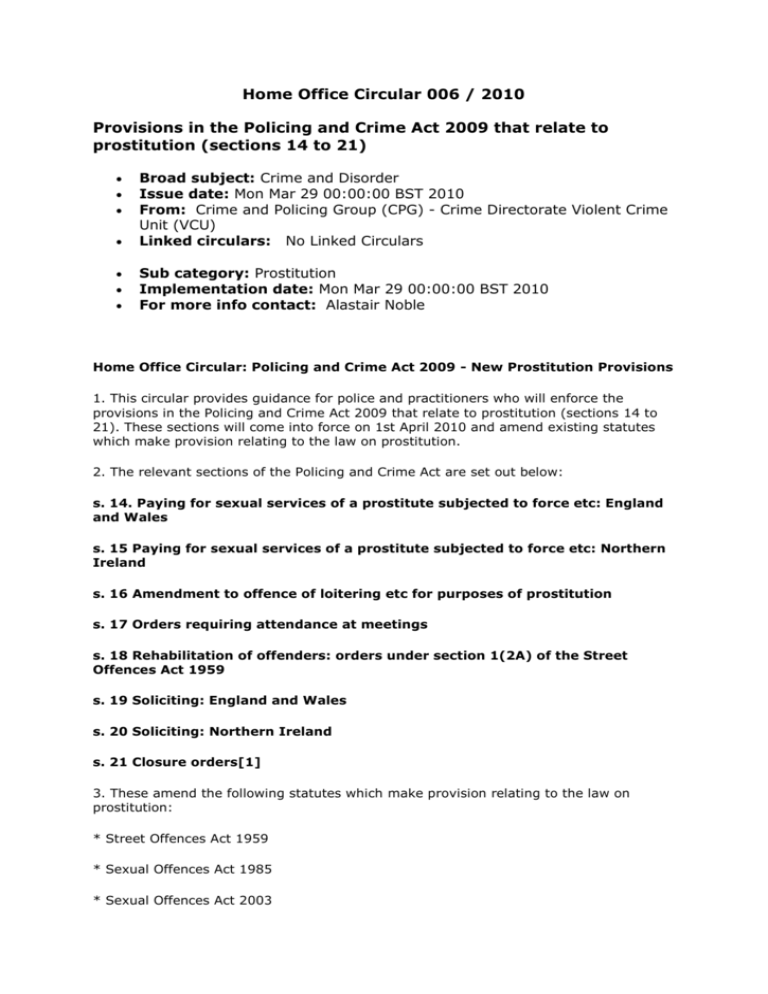
Home Office Circular 006 / 2010
Provisions in the Policing and Crime Act 2009 that relate to
prostitution (sections 14 to 21)
Broad subject: Crime and Disorder
Issue date: Mon Mar 29 00:00:00 BST 2010
From: Crime and Policing Group (CPG) - Crime Directorate Violent Crime
Unit (VCU)
Linked circulars: No Linked Circulars
Sub category: Prostitution
Implementation date: Mon Mar 29 00:00:00 BST 2010
For more info contact: Alastair Noble
Home Office Circular: Policing and Crime Act 2009 - New Prostitution Provisions
1. This circular provides guidance for police and practitioners who will enforce the
provisions in the Policing and Crime Act 2009 that relate to prostitution (sections 14 to
21). These sections will come into force on 1st April 2010 and amend existing statutes
which make provision relating to the law on prostitution.
2. The relevant sections of the Policing and Crime Act are set out below:
s. 14. Paying for sexual services of a prostitute subjected to force etc: England
and Wales
s. 15 Paying for sexual services of a prostitute subjected to force etc: Northern
Ireland
s. 16 Amendment to offence of loitering etc for purposes of prostitution
s. 17 Orders requiring attendance at meetings
s. 18 Rehabilitation of offenders: orders under section 1(2A) of the Street
Offences Act 1959
s. 19 Soliciting: England and Wales
s. 20 Soliciting: Northern Ireland
s. 21 Closure orders[1]
3. These amend the following statutes which make provision relating to the law on
prostitution:
* Street Offences Act 1959
* Sexual Offences Act 1985
* Sexual Offences Act 2003
4. The circular sets out the key legislative changes; explains the policy behind the
changes; and sets out issues that may need to be considered when enforcing the
legislation.
Part 1 of this circular sets out the policy context for these changes and provides
background information which may need to be considered in enforcing this legislation.
Part 2 sets out the effect of the legislative changes which are aimed at dealing with the
demand for prostitution and which follow recommendations in the Government's 2008
publication: 'Tackling the Demand for Prostitution: A Review'. These changes are
introduced by sections 14-15, 19-20 and 21 of the Policing and Crime Act 2009,
which make amendments to the Sexual Offences Act 2003.
Part 3 concerns the changes made to the Street Offences Act 1959 by sections 16-18
of the Policing and Crime Act 2009. They update the law relating to the policing of street
prostitution and introduce a new Engagement and Support Order which will be available
to courts as an alternative punishment to a fine, for the offence of loitering or soliciting
for the purposes of prostitution.
Annex A sets out some of the key legislation relating to prostitution.
1. Context and Background
5. This circular is primarily aimed at setting out the law in relation to prostitution but in
enforcing this law it is important that the overall context in which prostitution exists, and
the circumstances of those involved in the particular offences (both as offenders and
victims) are taken into account. A 'Co-ordinated Prostitution Strategy' (published
January 2006) sets out the context of Government policy underpinning the legislative
changes. It also sets four key objectives which are to:
* challenge the view that street prostitution is inevitable and here to stay
* achieve an overall reduction in street prostitution
* improve the safety and quality of life of communities affected by prostitution, including
those directly involved in street sex markets
* reduce all forms of commercial sexual exploitation.
6. The consultation paper which preceded the strategy, 'Paying the Price' (July 2004)
sets out the context about those involved in prostitution and those paying for sex. This
information is summarised below with additional information relevant to understanding
and policing prostitution.
Women and men involved in prostitution
7. Both national and international studies indicate that for many women, men and
children involved in prostitution the experience is one that involves physical, mental and
sexual violence. This can cause trauma and significant, long-lasting physical and
emotional harm. Research carried out on the harm caused by prostitution to women
involved in it found that:
* 71% of women interviewed had experienced physical assault;
* 63% had experienced rape; and
* 68% met the criteria for post-traumatic stress disorder.[2]
8. Analysis of routes into prostitution identified that:
- Certain vulnerable groups of girls and women were more likely to become involved in
prostitution, particularly those who had suffered physical or sexual violence or neglect.
- This group were further marginalised by experiences which included running away from
abusive situations, being in local authority care, being involved in crime, drug addiction
and being excluded from education.
- These girls and women were then 'facilitated' into prostitution as a result of grooming
by pimps or other procurers[3].
9. Three-quarters of those involved in prostitution in Britain entered prostitution before
their 18th birthday.[4] As the Court of Appeal noted in R v Massey [2007][5] those
involved in prostitution "are often vulnerable young women with disturbed
backgrounds, who have never known a stable relationship or respect from
others and are therefore prey to pimps. It is all too easy for such a person to
fall under the influence of a dominant male, who exploits that vulnerability for
financial gain."
10. Consequently, agencies involved in the Criminal Justice System (CJS) will only be
able to deal with prostitution effectively if they understand its causes and consequences
and adopt a 'victim centred' approach to those who are sexually exploited.
Paying for sexual services
11. The changes made to legislation that are described in this circular have been
developed, in part, to enable the UK to meet its international legal obligations to
discourage the demand for sexual services. Article 9.5 of the United Nations' 'Protocol to
Prevent, Suppress and Punish Trafficking in Persons, Especially Women and Children'
(2000) requires States to "discourage the demand that fosters all forms of exploitation of
persons, especially women and children that leads to trafficking". The Council of Europe
Convention on Action Against Trafficking in Human Beings[6] also requires States to
analyse the factors that result in women being trafficked and suppress them, including
the demand to sexually exploit women.
Controllers and traffickers
12. Those involved in providing sexual services may be controlled or coerced by a third
party who is often referred to as a 'pimp'. This third party may have groomed or coerced
the individual concerned into prostitution in addition to exploiting their involvement in it.
The pimp may be part of an organised crime network, but may equally be an abusive
'partner' or 'friend' of the person involved in prostitution.
2. Measures to tackle demand: paying for sex with a prostitute subject to force
etc; soliciting and closure orders. Paying for sexual services of a prostitute
subject to force etc
13. Section 14 of the Policing and Crime Act 2009 inserts section 53A into the
Sexual Offences Act 2003. This creates a new criminal offence in England and
Wales of paying for the sexual services of a prostitute who is, or has been,
subject to force.
14. Section 15 of the Policing and Crime Act 2009 inserts article 64A into the
Sexual Offences (Northern Ireland) Order 2008 to create the equivalent offence
in Northern Ireland.
15. An offence under section 53A (and 64A) is committed if:
(a) A person (A) makes or promises payment for the sexual services of a prostitute (B),
(b) a third person (C) has engaged in exploitative conduct of a kind likely to induce or
encourage B to provide the sexual services for which A has made or promised payment,
and
(c) C engaged in that conduct for or in the expectation of gain for C or another person
(apart from A or B).
16. Within this context 'A' is the buyer of sexual services, 'B' is the individual involved in
prostitution and 'C' is the person who has engaged in exploitative conduct.
Exploitative conduct
17. Under section 53A(3) exploitative conduct is conduct which involves the use of:
(a) force;
(b) threats (whether or not relating to violence);
(c) any other form of coercion; and,
(d) deception.
Force
18. Force should be given its ordinary meaning as applied in other legislation and clearly
includes physical violence towards B.
Threats
19. The "use of threats" is not restricted to threats of physical violence. For example, it
could also include scenarios where C uses 'psychological' threats against B. Scenarios
which could be covered by this include circumstances in which C makes threats to:
* report B to the immigration authorities or police;
* restrict B's access to B's children, family and friends;
* withdraw B's accommodation, financial support or other basic necessities;
* stop supplying B with drugs and/or alcohol;
* end the relationship; withdraw love/affection;
* take action that would make B feel guilty/responsible e.g. threaten to commit suicide;
threats in relation to the effect on C of not being able to purchase drugs and/or alcohol;
* restrict B's movement or some other personal freedom;
* tell family, friends or community about B's involvement in prostitution or about some
other fact which would damage B's reputation or otherwise embarrass him or her;
and/or,
* harm B's family or someone else close to B.
Coercion
20. 'Any other form of coercion' is intended to include situations that involve dominating
or unequal relationships where C uses his or her influence over B, or purposely exploits
B's vulnerabilities to incite or encourage B to provide sexual services. These
vulnerabilities could relate to B's:
* young age,
* physical or mental incapacity, illness or disability;
* drug and/or alcohol dependency;
* history of experiencing violence or abuse;
* economic disadvantage, social status or social exclusion; and/or,
* immigration status.
21. In R v Massey [2007] [7] the Court of Appeal considered some of the
vulnerabilities that could be exploited by C:
"There may be a variety of reasons why the other person does as instructed. It
may be because of physical violence or threats of violence. It may be because
of emotional blackmail, for example, being told that "if you really loved me, you
would do this for me". It may be because the defendant has a dominating
personality and the woman who acts under his direction is psychologically
damaged and fragile. It may be because the defendant is an older person and
the other person is emotionally immature. It may be because the defendant
holds out the lure of gain, or the hope of a better life. Or there may be other
reasons".
Deception
22. Deception relates to situations where B is deceived into providing the sexual
services. It could include deceiving B in relation to the identity of the person receiving
the sexual services or as to the terms on which the sexual services would be provided.
Strict liability
23. The offence is one of strict liability, which means that is irrelevant whether A is, or
ought to be, aware that B has been subject to exploitative conduct by C (i.e. force,
threats, other forms of coercion or deception).
Place where the services are provided
24. An offence is committed if A makes or promises payment for the sexual services. As
long as the payment or promises of payment occurred in England or Wales (or Northern
Ireland in the case of article 64A of the Sexual Offences (Northern Ireland) Order 2008)
it is irrelevant where in the world the sexual services are to be provided or whether
those services are provided.
25. This offence is not limited to particular localities or types of premises. So it could
apply to situations where, for example, the sexual services are provided in a place that
may have a legitimate business front (e.g. a nightclub) as well as internet-based
services.
26. It is also irrelevant whether the sexual services are provided to, or intended, for A or
a third party.
Definition of the terms "prostitute" and "gain"
27. For the purpose of this offence "prostitute" and "gain" has the same meaning as is
given in sections 51 and 54 of the Sexual Offence Act 2003 respectively. These
definitions are as follows:
"Gain" means:
* any financial advantage, including the discharge of an obligation to pay or the
provision of goods or services (including sexual services) gratuitously or at a discount; or
* the goodwill of any person which is or appears likely, in time, to bring financial
advantage.
"Prostitute" means:
* a person who, on at least one occasion and whether or not compelled to do so, offers
or provides sexual services to another person in return for payment or a promise of
payment to the person offering or providing sexual services or a third person.
Maximum penalty
28. A person guilty of this offence is liable on summary conviction to a fine not
exceeding level 3 on the standard scale.
Soliciting
29. Section 19 of the Policing and Crime Act 2009 introduces a new section 51A to the
Sexual Offences Act 2003 (section 20 of the Policing and Crime Act 2009 inserts
equivalent article 60 into the Sexual Offences (Northern Ireland) Order 2008). This
creates a new offence of soliciting a person in a street or public place for the purpose of
obtaining sexual services from them as a prostitute. This replaces the offences of kerb-
crawling and persistent soliciting (Sexual Offences Act 1985), which are repealed by the
Policing and Crime Act 2009
30. The effect of this section is to remove the requirement to prove persistence. So,
unlike the existing offences, this new offence will allow the prosecution of an offender on
the first occasion that they are found to be soliciting and without the need to prove
persistent behaviour or, as was the case with the previous offence of kerb-crawling in
the Sexual Offences Act 1985, that the behaviour is likely to cause annoyance or
nuisance to others.
Repeal of Sexual Offences Act 1985
31. Schedule 8 of the Policing and Crime Act 2009 repeals the Sexual Offences
Act 1985.
32. This repeals the offences of kerb-crawling and persistent soliciting in that Act. They
are replaced by the single offence of soliciting (new section 51A of the Sexual Offences
Act 2003).
Closure Orders
33. Section 21 of, and Schedule 2 to the Policing and Crime Act 2009 inserts a new Part
2A into the Sexual Offences Act 2003, which introduces powers allowing the police to
seek a court order prohibiting access to premises associated with certain prostitution or
pornography-related offences. These are similar to existing powers to close premises
associated with disorder or Class A drugs under the Anti-Social Behaviour Act 2003.
34. In issuing a closure notice and applying for a Closure Order, the police or anyone
else exercising their functions under these provisions must have regard to any guidance
issued by the Secretary of State. This guidance will be issued in advance of
commencement and will be available on the Home Office website. A summary of the
powers and the process that needs to be followed is provided below.
35. The relevant offences are listed in section 136A of the Sexual Offences Act 2003.
They are:
* Paying for the sexual services of a child (section 47 of the Sexual Offences Act 2003
Act or Article 37 of the Sexual Offences (Northern Ireland) Order 2008.
* Causing or inciting child prostitution or pornography (section 48 of the Sexual Offences
Act 2003, or Article 38 of the Sexual Offences (Northern Ireland) Order 2008.
* Controlling a child prostitute or a child involved in pornography (section 49 of the
Sexual Offences Act 2003 or Article 39 of the Sexual Offences (Northern Ireland) Order
2008.
* Arranging or facilitating child prostitution or pornography (section 50 Sexual Offences
Act 2003), or Article 40 Sexual Offences (Northern Ireland) Order 2008.
* Causing or inciting prostitution for gain (section 52 of the Sexual Offences Act 2003 or
Article 62 of the Sexual Offences (Northern Ireland) Order 2008.
* Controlling prostitution for gain (section 53 of the Sexual Offences Act 2003 or Article
63 of the Sexual Offences (Northern Ireland) Order 2008.
36. The Closure Order provisions will not come into force in Northern Ireland on 1st
April.
37. Before applying to a court for a Closure Order, a police constable must issue a
Closure Notice. The process for issuing a closure notice is set out in section 136B of the
Sexual Offences Act 2003. The issue of a closure notice must be authorised by an
officer of at least the rank of superintendent or above (the authorising officer).
38. A Closure Notice should be authorised in writing. But where written consent is not
immediately possible, oral authorisation is sufficient as long as it is confirmed in writing
as soon as is practicable afterwards.
39. A Closure Notice can be authorised by an authorising officer if there are reasonable
grounds for believing that the following three conditions are met:
1. During the last 3 months the premises were used for activities relating to one or more
of the specified prostitution or pornography offences.
2. A Closure Order is necessary to prevent the premises being used for activities related
to the specified offences.
3. That the local authority for the area in which the premises are situated has been
consulted, and that reasonable steps have been taken to establish the identity of any
person who resides on the premises or who has control of or responsibility for or an
interest in the premises.
40. Once a Closure Notice has been issued, an application for a Closure Order must be
made to the magistrates' court by the police within 48 hours.
41. The statutory guidance sets out further detail about the process to be followed and
the issues to be considered when seeking a Closure Order. These are significant powers
and due consideration should be given to the issues set out in the statutory guidance.
3. Amendments to the Street Offences Act 1959: removal of the term 'common
prostitute'; definition of persistence; Engagement and Support Orders
42. This circular updates and replaces the 1959 Home Office Circular accompanying the
Street Offences Act 1959.
Removal of the term 'Common' Prostitute
43. Section 16 of the Policing and Crime Act 2009 amends section 1 of the
Street Offences Act 1959 to remove the term 'common prostitute' and insert
the word 'persistently' and 'person' into the offence of loitering or soliciting for
the purposes of prostitution.
44. This responds to a widespread consensus that the term 'common prostitute' is
outdated and offensive and should be removed.
45. The term 'common' having been removed it is necessary to ensure that this does not
have the unintended effect of allowing the prosecution of those who have not been
loitering or soliciting on a persistent basis. In place of 'common prostitute' the Policing
and Crime Act 2009 inserts the words 'person' and 'persistently' so that the offence will
now be committed by a person involved in prostitution 'who persistently loiters or solicits
in a street or public place for the purpose of prostitution'. Persistence is defined as
conduct that takes place on two or more occasions in any three month period. This is
intended to ensure that current practice is maintained.
46. Current practice, as established by the 1959 Home Office Circular, is to use a nonstatutory 'prostitutes' caution' to demonstrate that a person is involved in prostitution
and offenders are not prosecuted until at least 2 cautions have been given. It is
expected that prostitutes' cautions will continue to be used to demonstrate 'persistence'
under the amended legislation.
47. Two officers would need to witness the activity and administer the caution. Details of
these 'prostitutes' cautions' are recorded at the local police station. However there are
two respects in which prostitutes' cautions differ from ordinary police cautions:
* The behaviour leading to a caution may not itself be evidence of a criminal offence for
which the prostitute could be prosecuted
* There is no requirement for a woman to admit guilt before she may be given a
'prostitutes caution', unlike an ordinary police caution.
48. The caution is not a formal pre-requisite of conviction but it has become the way in
which evidence is adduced to prove that an individual charged for the first time is a
'common prostitute.' It is expected that 'prostitutes' cautions' will continue to be used to
adduce evidence of persistence.
49. The insertion of the word "persistently" provides opportunities for the police, where
they encounter an individual engaging in street prostitution for the first time in any 3
month period, to direct that individual to non-criminal justice interventions. Such
interventions may help the individual involved to address the issues that may have
caused them to enter prostitution, such as drug dependency or historic sexual abuse and
ultimately, to find routes out. Where successful, this approach can prevent vulnerable
individuals from becoming involved in the CJS.
50. Where the police do encounter someone loitering or soliciting on a persistent basis
they may still want to consider whether a non-criminal justice intervention may be the
most appropriate intervention, and contact a local project or service to explore this
option.
51. If it is decided that a criminal charge is necessary the police will want to consider
whether an order under section 17 (see below paragraphs 55-58) may be appropriate
and take early steps to explore this option in order that the CPS advise the court of the
appropriateness of such an order following conviction.
Repeal of section 2
52. Section 16 of the Policing and Crime Act 2009 also repeals section 2 of the
1959 Act, which allows a person cautioned for loitering or soliciting to apply to
a magistrates' court to have the caution removed from the police record. This
section has fallen into disuse and no longer serves a useful purpose.
Under 18s found loitering and soliciting
53. The offence of loitering or soliciting under the Street Offences Act 1959 is applicable
to those under 18. However, when a child who is being sexually exploited in street
prostitution comes to the attention of the police, the police must treat securing the
welfare of the child as their priority and should only consider criminal sanctions as a last
resort when all other options have been exhausted.
54. This approach is in accordance with guidance issued by the Department for Children,
Schools and Families 'Safeguarding Children from Sexual Exploitation' (June 2009) which
states that:
"the criminal law is rarely an effective or appropriate response
to children and young people under the age of 18 found loitering or soliciting for the
purposes of prostitution and that the responsibility for the sexual exploitation of children
or young people lies with the abuser: either the person who pays for sex, in some way,
or the person who grooms the child and/or organises the exploitation".
55. Action taken in relation to a child who is sexually exploited in prostitution should
comply with the UK's obligations under the United Nations Convention on the Rights of
the Child (1990), particularly Articles 34-36 which relate to child sexual exploitation and
sexual abuse. The Convention can be read here:
www2.ohchr.org/english/law/crc.htm#art33. In short, any steps taken, whether relating
to criminal proceedings or not, should be designed to protect the child from continuing
sexual exploitation and abuse.
Engagement and Support Orders
56. Section 17 of the Policing and Crime Act 2009 amends section 1 of the
Street Offences Act 1959 to introduce a new order which will be available to
courts as an alternative penalty to a fine for people convicted of loitering or
soliciting under section 1 of that Act. These will be called Engagement and
Support Orders.
57. The purpose of the order is to provide a penalty that is a more constructive option
than a fine. Fining someone involved in street prostitution can have the counterproductive effect of providing a further reason to continue engaging in prostitution in
order to pay the fine. Instead, this order will require the person involved in prostitution
to attend three meetings with a named supervisor who will help the individual address
the reasons for their involvement in prostitution with the aim of helping them find a
route out of prostitution.
58. Opportunities for diversion away from the CJS into welfare based interventions
should always be considered in place of criminal sanctions. However, when the decision
to pursue criminal charges has been made, the benefits of seeking an order requiring
attendance at meetings should be considered at an early stage. Where effective
partnerships between police and welfare-based intervention services have been
established, this relationship should be used to discuss the merits of seeking an order
and its supervision.
59. Detailed Home Office guidance setting out the process for seeking and administering
an order and the issues to be considered will be published shortly and will be available
on the Home Office website.
Rehabilitation of Offenders Act 1974
60. Section 18 of the Policing and Crime Act 2009 amends Section 5 of the
Rehabilitation of Offenders Act 1974. It applies to the rehabilitation periods for
those convicted of loitering or soliciting for the purposes of prostitution and
sentenced to an order under section 1 of the Street Offences Act 1959 (see
above paragraphs 55-58).
61. For those sentenced to an order requiring attendance at meetings the rehabilitation
period will be six months. This is intended to accord with the maximum length of the
Engagement and Support Order. When the order has been completed, the person who
has been subject to the Order will have become a rehabilitated person under the
Rehabilitation of Offenders Act 1974.
62. Section 6 of the Rehabilitation of Offenders Act 1974 is amended to insert a new
subsection (3A). It applies when someone who has been given an order breaches it and
is re-sentenced for the same offence after the original six-month rehabilitation period
has expired. In cases where the rehabilitation period for the new sentence ends later
than that of the original order, the offender will not be treated as rehabilitated under the
1974 Act until the longer period has expired.
Annex A - The law relating to prostitution
Controlling, exploiting and trafficking
The offences principally directed against those who exploit others through prostitution
include controlling prostitution for gain and causing or inciting prostitution for
gain both of which have a maximum penalty of 7 years (Sexual Offences Act 2003).
These offences replace a number of old offences found in the Sexual Offences Act 1956
such as living off the earnings of a person involved in prostitution.
The main offence relating to brothels is keeping a brothel used for prostitution, the
penalty for which is 7 years (section 33A of the Sexual Offences Act 2003).
The Sexual Offences Act 2003 introduced the offences of trafficking into, within and
out of the UK for sexual exploitation (section 48-50 of the Sexual Offences Act
2003). These offences cover both adults and children and carry penalties of up to 14
years.
The Sexual Offences Act 2003 also introduced new offences specifically in respect of the
exploitation of children and young people. These are causing or inciting child
prostitution, controlling a child prostitute, and arranging or facilitating child
prostitution (section 48-50). The new offences cover the prostitution of both boys and
girls and all carry a maximum penalty of 14 years.
Section 21 of the Policing and Crime Act 2009 amends the Sexual Offences Act 2003 to
introduce closure orders. These allow the police to apply to a court for an order closing
premises associated with specified prostitution or pornography related offences for up to
three months (which can be extended by up to 3 months if the court deems it necessary.
However the total period for which the order has effect must not exceed 6 months).
Paying for sexual services
The Sexual Offences Act 2003 has been amended by the Policing and Crime Act 2009 to
introduce a new offence which makes it illegal to pay for the sexual services of a
prostitute subjected to force, threats (whether or not relating to violence) or
any other form of coercion or any form of deception of a kind likely to induce or
encourage the person involved in prostitution to provide those services. It is not a valid
defence for a defendant to argue that he did not know the person involved in prostitution
had been subject to force etc. The maximum penalty is a level 3 fine (section 53A Sexual
Offences Act 2003).
In respect of the abuse of a child through prostitution, the 2003 Act introduced an
offence of paying for the sexual services of a child, for which the maximum penalty
is life when the child is under 13 and the offence involves penetration; otherwise 14
years when the child is under 16, or 7 years if the child is 16 or 17.
The Sexual Offences Act 2003 has been amended by the Policing and Crime Act 2009 to
create an offence of soliciting a person in a street or public place for the purpose of
obtaining sexual services from that person as a prostitute. This can include a person
soliciting from a vehicle in a street or public place and replaces the offences of kerb
crawling and persistent soliciting found in the Sexual Offences Act 1985.
Men and women involved in street-based prostitution
The Street Offences Act 1959 criminalises loitering or soliciting for the purposes of
prostitution. It is an offence for a person persistently to solicit or loiter in a street or
public place for the purposes of prostitution. Conduct is persistent, for the purposes of
this offence, if it takes place on two or more occasions in any period of three months.
The maximum penalty is a level 3 fine or an Engagement and Support Order.
[1] Closure orders will not come into force in Northern Ireland on 1st April 2010.
[2] Farley, M (2003) Prostitution and Trafficking in Nine Countries: An update on
Violence and Posttraumatic Stress Disorder in the Journal of Trauma Practice.
[3] R Matthews Prostitution, Politics and Policy, 2008, Routlage. [sic]
[4] Research indicates that the average age of first involvement in prostitution in the UK
is 15 years old see Paying the Price page 16 [online version provides link to
www.homeoffice.gov.uk/documents/paying_the_price.html]
[5] EWCA Crim 2664. This case involved an appeal against conviction for an offence
contrary to section 53 of the Sexual Offences Act 2003
[6] CETS No. 197/2005
[7] EWCA Crim 2664. This case involved an appeal against conviction under section
53(1) of the Sexual Offences Act 2003

